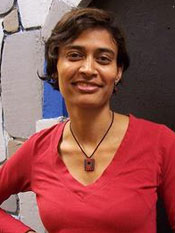
ENS, Salle séminaire DEC, 29 Rue d'Ulm, 75005 Paris
 Megha Sundara will be invited professor at ENS from June 20 to July 14. She will give the following three talks.
Megha Sundara will be invited professor at ENS from June 20 to July 14. She will give the following three talks.
Wednesday June 21, 10h30: The emergence of grammatical class in infancy
Salle séminaire DEC
RdC aile droite
29 Rue d'Ulm
75005 Paris
Abstract:
Establishing grammatical categories of words is necessary to acquire syntax. In some proposals, it is also necessary to acquire morphology (Pinker & Ullman, 2002). In four experiments (n=~500), I will show that instead, infants use morphological suffixes themselves to discover noun and verb categories in English.
Tuesday July 4, 14h: What do infants know about permissible sound sequences in their native language?
Salle Ribot
RdC aile gauche
29 Rue d'Ulm
75005 Paris
Abstract:
Languages differ in their phonotactics – that is, the position and sequencing of adjacent and non-adjacent segments within words. My goal is to identify what infants encode into representations to acquire phonotactics, when, and how they might do so. To answer these questions, I will integrate findings from a meta-analysis (n=~1400), with experimental results from adults (n=~300), infants (n=~160) and machines.
I will first show that 4-month-olds are sensitive to a typologically common harmony pattern where non-adjacent vowels in a word agree in backness, independent of language experience. Thus, the learning of some phonotactic patterns is privileged, because it is supported by infants’ initial perceptual abilities, consistent with Attunement theories of perceptual development (Aslin & Pisoni, 1980; Aslin et al., 2002).
Many of the sequencing restrictions on segments though are unique to a given language, and therefore must be learned from the input infants receive. I will show that sensitivity to adjacent segmental restrictions is induced by 5 months of age. Then using machine learning I will evaluate prelexical (e.g., Adriaans & Kager, 2010) versus lexical (e.g., Thiessen, Kronstein & Huffnagle, 2013) hypotheses about phonotactic acquisition.
Thursday July 6, 11h30: How infants discover morphological suffixes and use them to discover phonemes: Experimental and Computational findings
Salle de réunion IJN
Pavillon Jardin
29 Rue d'Ulm
75005 Paris
Abstract:
Morphological suffixes like -s, -ed and -ing are the basic building blocks of English syntax. In this talk I will present research to identify the representations, time course and the mechanisms involved in the acquisition of morphology. To do so, I will integrate looking time experiments with infants (n=~350), corpus analysis and computational modeling.
I will show that English-learning infants begin to discover suffixes before 6-months. And they do so without access to meaning, or function. Additionally, I will show that infants use morphological suffixes to discover phonemes. The early discovery of suffixes is problematic for whole word models of acquisition where morphology is a by-product of shared form and meaning (Baayen et al., 2015; Tomasello, 2000). Instead, I will argue that infants represent morphemes from the earliest stages of acquisition, and that morphological acquisition precedes the discovery of phoneme (and word class).
Next, I will use computational modeling to provide a formally explicit account for how these suffixes could be learned. Model performance will be evaluated against the developmental trajectory of morphological acquisition uncovered in the infant experiments. Then, I will use the computational model as a guide to pinpoint infant experiments likely to distinguish alternate theories of morpheme discovery. Finally, I will set up predictions for the trajectory of morphological acquisition in infancy in French, Spanish and German.
